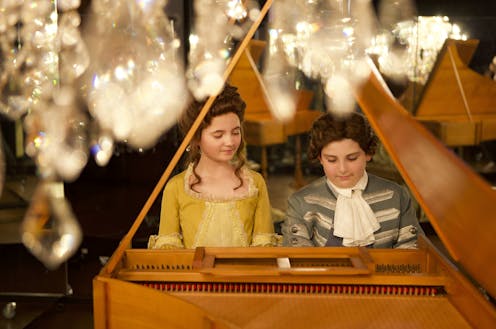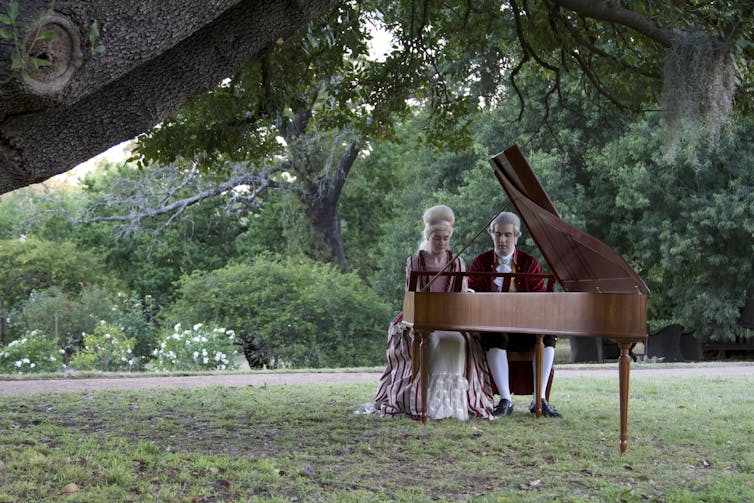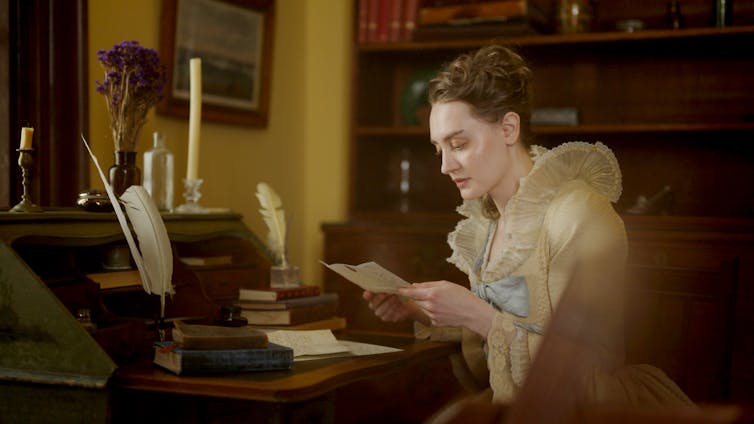
Award-winning director Madeleine Hetherton-Miau’s latest offering is an evocative and hard-hitting documentary with a strong message. Mozart’s Sister investigates the life of Maria Anna Mozart, the older sister of the more famous Wolfgang Amadeus Mozart.
The film portrays a sensitive and well-researched investigation into Maria Anna’s life – illuminating how the draconian attitudes that prevailed during her time condemned her to a lesser life than her brother, even though she was similarly talented.
It also reminds us of the importance of championing women musicians today, as “if we don’t encourage women now, it (discrimination) only repeats”.
Who was Maria Anna Mozart?
Maria Anna was the first-born child of Leopold Mozart. He himself was a musician and composer and had his daughter schooled in music from a very young age.
Maria showed amazing talent – a child prodigy in playing and composing. When Wolfgang was born, he quickly became engrossed in playing and composing music with his sister.
Mozart’s Sister features wonderfully poignant recreations of this childhood bond over music – emphasising the siblings’ playfulness and engagement with music in a noncompetitive way.
Leopold recognised his children’s prodigious talents. He soon had them travelling and playing concerts all over Europe, where they were lauded by the highest aristocracy. Maria Anna and Wolfgang were inseparable during this time and composed many works together.

Women musicians in the 18th century
But all of this came to an abrupt end with Maria Anna turned 15. As custom would dictate, it was considered unsuitable and unseemly for a girl of that age to perform in public, likening this form of public performance to that of a prostitute.
The film portrays the unfortunate fate that befell many 18th-century women who wanted to pursue a career in music. Regardless of their aptitude, these women would have no real career prospects. They were even banned from playing musical instruments deemed unseemly, including the violin and cello.
Composing and playing music was largely taken up by the nuns in monasteries. As Mozart’s Sister highlights, even though this was a time of enlightenment, this “enlightenment” was reserved for men – and white men at that. It definitely didn’t flow on to women.
Maria Anna was forced to stay home while Wolfgang continued pursuing music uninterrupted – and the rest is history.

The film ponders what it must have been like for her to be left at home, away from her brother (who was once her constant companion) and unable to play as she used to. Her life is poignantly illustrated through her diary entries, which are mainly filled with references to the weather, as though nothing else was happening for her.
Maria Anna eventually married, but continued to practice music each day. Upon her husband’s death – now a woman of means and a baroness in her 50s – she returned to solo concert performances.
A documentary on two levels
Mozart’s Sister is a documentary that functions on many levels.
On one level, it’s a biopic that portrays Maria Anna’s story through recreations of her childhood in Austria, with a voiceover narration and interviews highlighting her relationship with her brother. Much is shot on location in Austria and framed through the perspective of present-day museum curators and experts.
On another level, the film is a broader statement on the underrepresentation of female composers. I thought the director did an excellent job in portraying this duality through the juxtaposition of Maria Anna’s with the young British composer Alma Deustger. Deustger displayed many of the characteristics we could imagine Maria Anna having.
Like Maria Anna, Deustger is a brilliant modern-day composer with a deep appreciation for for composing and conducting. But unlike Maria, she has been able to pursue her passion and turn it into a career. I was particularly struck by the film’s closing, in which Deustger discusses writing her waltz based on the police sirens of New York.
Mozart’s Sister follows in a recent literary trend of discussions of appropriation – and of the overlooking of talented women in history who have been overshadowed by their more famous male counterparts. Anna Funder’s Wifedom and Hernan Diaz’s Pulitzer Prize-winning book Trust are two other examples of this.
It is an interesting and provocative film that will appeal to classical music lovers, as well as those interested more broadly in the issue of female underrepresentation in the arts.
Mozart’s Sister is in cinemas from today.
Diane Charleson does not work for, consult, own shares in or receive funding from any company or organisation that would benefit from this article, and has disclosed no relevant affiliations beyond their academic appointment.
This article was originally published on The Conversation. Read the original article.







